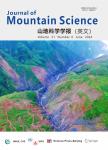Spatial pattern recognition for near-surface high temperature increases in mountain areas using MODIS and SRTM DEM
作者机构:School of Soil and Water ConservationSouthwest Forestry UniversityKunming 650224China School of Economics and ManagementSouthwest Forestry UniversityKunming 650224China
出 版 物:《Journal of Mountain Science》 (山地科学学报(英文))
年 卷 期:2024年第21卷第6期
页 面:2025-2042页
核心收录:
学科分类:0830[工学-环境科学与工程(可授工学、理学、农学学位)] 07[理学] 070601[理学-气象学] 0706[理学-大气科学]
基 金:supported by the National Natural Science Foundation of China (Grant No. 42061004) the Joint Special Project of Agricultural Basic Research of Yunnan Province (Grant No. 202101BD070001093) the Youth Special Project of Xingdian Talent Support Program of Yunnan Province
主 题:High temperature increase Mountain areas MODIS Spatial pattern recognition Raster window measurement Threshold selection
摘 要:Abrupt near-surface temperature changes in mountainous areas are a special component of the mountain climate *** and accurate measurements of the locations,intensity,and width of the near-surface changes are necessary but highly difficult due to the complicated environmental conditions and instrumental *** paper develops a spatial pattern recognition method to measure the near-surface high temperature increase(NSHTI),one of the lesser-attended ***,raster window measurement was proposed to calculate the temperature lapse rate using MODIS land surface temperature and SRTM DEM *** fully considers the terrain heights of two neighboring cells on opposite or adjacent slopes with a moving window of 3×3 cell ***,a threshold selection was performed to identify the NSHTI cells using a threshold of-0.65℃/100 ***,the NSHTI strips were parameterized through raster vectorization and spatial *** Yunnan,a mountainous province in southwestern China,as the study area,the results indicate that the NSHTI cells concentrate in a strip-like pattern along the mountains and valleys,and the strips are almost parallel to the altitude contours with a slight northward ***,they are located mostly at a 3/5 height of high mountains or within 400 m from the valley floors,where the controlling topographic index is the altitude of the terrain trend surface but not the absolute elevation and the topographic uplift height and cutting ***,the NSHTI intensity varies with the geographic locations and the proportions increase with an exponential trend,and the horizontal width has a mean of about 1000 m and a maximum of over 5000 *** result demonstrates that the proposed method can effectively recognize NSHTI boundaries over mountains,providing support for the modeling of weather and climate systems and the development of mountain resources.



